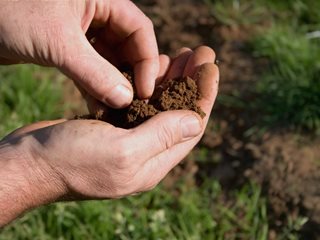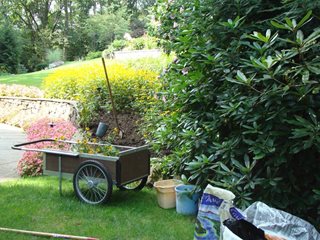How To Use Garden Soil
Gardeners frequently disregard the impact soil has on the health and vigor of their plants. Soil preparation isn't the nigh thrilling aspect of planting a garden, just information technology's certainly one of the almost important. If your soil isn't right, your garden will struggle to accomplish its full potential.

Kickoff by digging upwards a scoop of soil and examining its texture in your hands. Photo past: Sharon Kingston / Shutterstock
"A garden is a reflection of the quality of its soil. Gardens filled with beautiful soil have a vitality nearly them that we tin can virtually feel," says mural designer and writer January Johnsen.
Achieving that vitality requires understanding the chemistry and composition of your soil and creating the perfect environment for fertile plant growth. Practiced soil management is a continual process, but in one case you attend to the nuts, your soil will do most of the work itself.
6 Basics of Healthy Soil
- Know Your Soil Type
- Test the pH of Your Soil
- Amend with Organic Matter
- Enlist the Help of Microorganisms
- Mulch with Care
- Favor a No-Till Approach
1. Know Your Soil Blazon
Before yous begin planting, dig up a scoop of soil and take a look at its texture. Is it dense and heavy and clump together when wet? Or is information technology loose and free flowing, similar play sand? Maybe it'due south somewhere in between, feeling somewhat mucilaginous but crumbling easily, like a freshly broiled cookie.
All soils are a mixture of mineral particles — primarily dirt, sand, and silt. Oft they will contain higher amounts of one type of particle relative to the others. That doesn't brand them bad growing mediums, but information technology volition bear upon their density, drainage rate, and capacity to concur nutrients.
With each soil blazon, there are trade-offs. Hither'southward a quick overview:
- Clay soils have tiny, dumbo particles that hold large reserves of moisture and nutrients. Nonetheless, clay soil also drains slowly and tin become hard and compacted when dry.
- Sandy soils are just the contrary, with large particles that water moves through easily — along with important nutrients.
- Silts take fine particle sizes that pack together tightly, inhibiting drainage and air circulation.
- Loam is the ideal soil for nigh plants; it contains a residue of all three mineral particles and is rich in humus (what'due south left afterwards organic matter decomposes).
If you have poor soil, consider building a raised garden bed and filling information technology with a well-balanced soil mix. Photo by: Jan Johnsen.
Adding organic matter is the best way to make your soil more than loam-like and meliorate its structure. Another option is to build a raised garden bed and make full it with a well-counterbalanced soil mix. Or accept the unproblematic approach by growing plants that do well in your soil type, such equally choosing drought-tolerant plants for sandy soils. You can grow a garden successfully in whatsoever soil, as long every bit the found's roots are accepted to the conditions.
ii. Exam the pH of Your Soil
The pH of your soil is one of the most of import factors in determining its fertility. If your soil is besides element of group i (with a pH above seven.five) or to acidic (with a pH below 5.5), that can brand a big divergence in which nutrients are available to your plants.
Although most plants volition tolerate a wide range of pH levels, they adopt slightly acidic soils (with a pH of half-dozen to 7) considering of import nutrients such equally nitrogen, phosphorus, potassium, calcium and magnesium deliquesce readily in that surroundings. In soils that are too acidic or alkaline, your plants may get too much of some nutrients and not enough of others.
When testing the pH of your soil, accept samples from dissimilar sites in your garden because the pH can vary even within a small backyard. Photograph by: Jan Johnsen.
How practice you test your soil pH? Here are two options:
- DIY Soil Test Kit: For the quickest results, you tin buy an instant-read soil examination kit or electronic tester (such as this one from Amazon).
- Professional Soil Analysis: But if you lot're starting a new garden, it's a skilful idea to take your soil tested professionally. The soil samples volition be sent to a lab, which will analyze your soil pH and nutrient content too as its capacity to retain nutrients. Try the Soil Savvy Test Kit, also bachelor on Amazon.
Be sure to accept soil samples from different sites in your garden considering the pH tin vary quite a scrap, even within a small lawn. If your pH reading is low (acidic), you can correct it by calculation lime to your soil. If it's as well high, add together powdered sulfur or aluminum sulfate. Another option is to choose plants that will thrive at the natural pH level of your soil, such as acid-loving rhododendrons or azaleas.
3. Meliorate with Organic Affair
Any blazon of soil can be improved past the improver of organic matter.
Here are three mutual amendments:
- Composted chiliad waste
- Manure
- Fallen leaves
In sandy soils, organic matter improves h2o-holding capacity and the retentivity of nutrients. In clay soils, it loosens upward the minerals that become sticky when the soil is wet and hard when the soil is dry out. And in all soils, information technology provides a rich supply of slow-release nutrients for your plants every bit well as nutrient for beneficial soil organisms. Over time, a well-amended soil will provide about of the nutrients your plants demand, reducing fertilizer requirements.

Most soil amendments piece of work all-time if you work them into the soil in the fall, so they are well decomposed before planting the following leap. Photo by: Jan Johnsen.
Most soil amendments work all-time if you work them into the soil in the fall, so they are well decomposed before planting the following spring, explains organic gardener Elizabeth Stell, writer of Secrets to Smashing Soil . To get the organic matter down to root level, employ a garden fork to mix the textile into the tiptop 4 to six inches of soil. In vegetable gardens, which usually contain annual or biennial plants, you can amend your soil each flavour. Perennial gardens should be amended prior to planting and then you won't disturb the plant roots. Many perennials must exist dug upward every few years for sectionalization, providing a good opportunity to work in boosted organic matter.
4. Enlist the Help of Microorganisms
Don't simply think of soil as clay. Think of information technology as microscopic world teeming with a vast array of organisms that breathe life into your garden. These organisms in your soil ecosystem — including earthworms, insects, fungi, and a multitude of beneficial bacteria — act every bit Mother Nature's recycling crew, converting dead leaves and establish debris into readily available nutrients. They likewise aid to aerate the soil and convert organic matter into humus.
Know Your Soil History
The history of your garden and how the soil has been treated — or mistreated — can likewise brand a big divergence in what it will take to improve it, says soil scientist Keith Reid, in his book Improving Your Soil . "Have you purchased a belongings in the land and want to create a garden in an sometime pasture? Do you desire to improve a garden that you take cultivated for many years with lots of TLC? Or are you trying to start a garden in what passes for soil in a new subdivision? Know the history of your garden, make a note of what plants have been grown, what fertilizer or manure has been applied, and what did well or poorly. These details will help reveal the potential limitations of your soil."
"To enlist the help of microorganisms, create favorable weather. As these are the same conditions that promote optimum constitute growth, you'll be doing your garden a double favor," says Stell. To encourage soil life, she recommends keeping your soil evenly moist and well aerated and minimizing the use of pesticides. "Many of these are toxic to soil life as well as to whatever insects y'all're trying to command," she says. Also avoid the use of concentrated fast-acting fertilizers, which can impairment earthworms and other soil organisms. Instead, utilise less-full-bodied organic fertilizers and slow-release formulas.
v. Mulch with Care
Mulching allows y'all to add together organic affair to the soil without disturbing plant roots because you lot simply spread it over the surface and let it decompose naturally.
Mulch also helps to:
- Retain moisture
- Suppress weed growth
- Go on the soil cooler during the summertime
- Improve soil aeration
Only mulch also has its pitfalls, especially if you use the wrong blazon of mulching textile and use information technology too thickly. It can change the chemical limerick of the soil and leach micronutrients that are harmful to plants. It can too create continually moist conditions that pb to fungal diseases of institute roots, especially in wet soils and humid climates.
A variety of organic materials can brand effective mulches. Yet, mulches aren't created equal when information technology comes to how they impact the biological activity of the soil and how quickly they break down. To acquire more about the pros and cons of mulching and the all-time types of mulches to use in residential gardens, see How to Mulch and Avoid Mistakes.
half-dozen. Favor a No-Till Approach
Gardeners have widely varying opinions about the benefits of tilling. Many are convinced that turning over and breaking upward the soil every yr creates a favorable environment for their plants because information technology helps to mix in organic affair and improve drainage. Others say that tilling is a waste of time and may really do more than harm than good — and frequently they are correct.
Tilling has a number of drawbacks. It can encourage the growth of weeds by bringing dormant seeds to the surface and exposing them to sunlight. It can disturb the beneficial burrowing activities of earthworms — the best costless labor you tin get for loosening and aerating your soil. It can as well interfere with the activity of important soil microorganisms. Despite these negatives, tilling is still a viable choice if you lot demand to work organic matter and nutrients into sticky clay soil or a new garden bed that's heavily compacted. Later on that initial deep tilling, you can oft let nature take its class to amend the structure of your soil.
NEW TO GARDENING?
If y'all're not certain where to showtime, the Garden Design editors recommend The New Gardener's Handbook: Everything You Need to Know to Grow a Beautiful and Bountiful Garden, by Daryl Beyers, an expert from the New York Botanical Garden. You'll detect easy-to-follow information on:
- Soil preparation
- Planting
- Watering
- Pruning
- Fertilizing
- and more than!
Purchase now on Amazon.
RELATED:
Composting 101: How to Compost
Potting Soil 101
Garden Fertilizer 101
How To Use Garden Soil,
Source: https://www.gardendesign.com/soil/
Posted by: robinsonweir1970.blogspot.com


0 Response to "How To Use Garden Soil"
Post a Comment